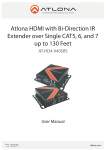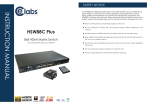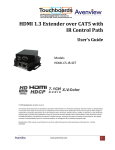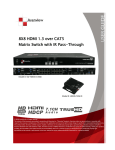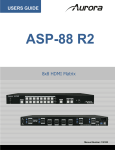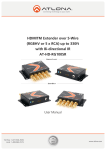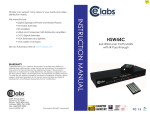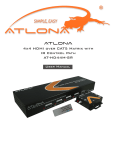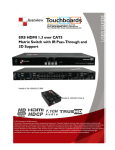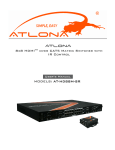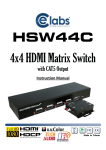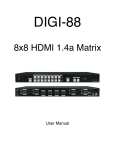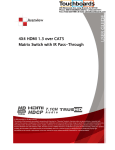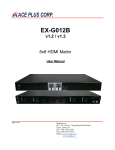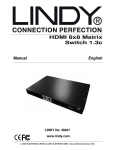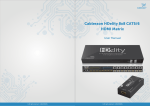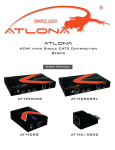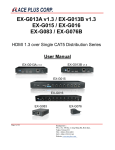Download Manual
Transcript
PRO-8X8-HDMI-CAT 8X8 HDMI Router User Manual Made in Taiwan rev.1008 103 Quality Circle, Suite 210 | Huntsville, Alabama 35806 | Tel: (256) 726-9222 | Fax: (256) 726-9268 | Email: [email protected] Safety and Notice The PESA PRO-8X8-HDMI-CAT 8X8 HDMI Router has been tested for conformance to safety regulations and requirements, and has been certified for international use. However, like all electronic equipments, the PRO-8X8-HDMI-CAT should be used with care. Please read and follow the safety instructions to protect yourself from possible injury and to minimize the risk of damage to the unit. z Follow all instructions and warnings marked on this unit. z Do not attempt to service this unit yourself, except where explained in this manual. z Provide proper ventilation and air circulation and do not use near water. z Keep objects that might damage the device and assure that the placement of this unit is on a stable surface. z Use only the power adapter and power cords and connection cables designed for this unit. z Do not use liquid or aerosol cleaners to clean this unit. Always unplug the power to the device before cleaning. Warranty Information PESA Switching Systems, Inc., (PESA) warrants this equipment against defective workmanship or materials for a period of one (1) year from date of shipment. The sole warranty responsibility of PESA, shall be to replace or repair product proved to be defective. During the warranty period, defective parts will be replaced at no charge. Labor to repair or replace defective parts covered under the warranty will be performed at no charge at PESA. This warranty covers only products manufactured by PESA, and the components used in their manufacture. The warranty on assembled products sold by PESA., but manufactured by others shall be that of the original manufacturer. This warranty does not include shipping damage or damage caused by abuse, neglect, tampering by unauthorized personnel, damage inadvertently caused by the user, preventative maintenance, or any equipment or part thereof whose serial number has been removed or defaced. Neither the seller nor the manufacturer shall be liable for any injury, loss or damage, direct or consequential, arising out of the inability to use the product. Before using, user shall determine the suitability of the product for the intended use, and user assumes all risk and liability whatsoever in connection therewith. This warranty is effective only at the PESA factory in Huntsville, Alabama, USA. If possible, retain the original packing material for use in the unlikely event that your equipment must be returned to the PESA factory. When shipping your equipment, the shipping charges must be prepaid. The repaired unit will be returned to you, freight prepaid. This warranty is exclusive and in lieu of all other warranties, whether expressed or implied, including the implied warranties of merchantability and fitness for a particular purpose. INTRODUCTION The PESA PRO-8X8-HDMI-CAT 8X8 HDMI Router provides the most flexible and cost effective solution in the market to route high definition video sources plus multi-channel (up to 7.1-channel) digital audio from any of the eight HDMI source devices to the remote displays at the same time. Through low cost Cat-5/5e/6 cables, not only high quality video and audio can be transmitted to the display sites, but also users can switch among eight HDMI sources using the push button on the receiver or remote control. With single power design at the source site, each remote module is easily installed without power supply. Furthermore, the built-in IR extension allows users to control the HDMI source devices such as the Blu-ray Disc player or satellite receiver at display site. 4 V# HDT r ive ece al R ign IR S 3 V# HDT iver IR C rce Sou SE INP LE U CT T iver r olle ontr 2 V# HDT H DM ece I al R DC SIG A/V NA L IVER CE RE IR C IR rce Sou CH CO AN NT NE RO L L r olle ontr 1 V# H DT + 5V ign ce l Re a ign IR S IR S iver ece al R ign IR S SE INP LE U CT T OU HD TP MI U T IR SIG A/V NA L IVER CE RE Con CH CO AN NT NE RO L L er troll ce IR + 5V DC r Sou SE INP LE U CT T + 5V DC SIG A/V NA L IVER CE RE r CH CO AN NT NE RO L L IR + 5V DC SIG A/V NA L IVER CE RE ed) CAT -5e P R O -8 X 8 -H D M IC A T clud UT OUTP 5 6 1 INPUT CE 5 6 1 SEL. DIS PLA 8 4 4 7 2 3 8 3 6 1 7 2 7 2 5 SOUR SID E Fn MA TRIX Y SID 8 3 E 4 POW ER iver ece R S DS SW 1 OU OU 1 1 1 EDID o Audi 2 1 SW IN 1 1 SW able IC HDM 1 EDID o Audi 2 1 SW IN 3 3 SW abl ter C lud e inc g acka e (P T3 T7 OU T8 TMD 2 2 3 2 8 IR 7 4 EDID S 1 o 2 Audi 1 SW 2 6 IR 5 T4 @ 35M 2 4 60 0p/ 108 S IR 3 IR 1 8 V# HDT r eive ec al R ign IR S 7 V# HDT as r ive ece al R ign r olle ontr 6 V# H DT rce Sou IR C SE INP LE U CT T r CE + 5V DC SIG A/V NA L IVER IR C RE rce Sou IR olle ontr 5 V# H DT CH CO AN NT NE RO L L I T OU HD TP M U iver ece al R ign S IR OU OU IN 7 7 2 iver ece al R ign S IR ed.) IR S T2 T6 le 2 a IR Bl OU OU 1 SW Cab 2 st l Bla ign T1 T5 1 2 er IR S TMD OU SW 1 EDID o Audi 2 IN 5 5 UTP 2 SE INP LE U CT T OU HD TP MI U T IR CE RE + 5V DC SIG A/V NA L IVER IR C CH CO AN NT NE RO L L r olle ontr rce Sou SE INP LE U CT T RE + 5V DC SIG A/V NA L IVER CE I Cat.X Cable CH CO AN NT NE RO L L IR CE RE HDMI Cable 5V DC (Pac SIG A/V NA L IVER HDM Cab le O HD M iver IR ble > I Ca ece SE INP LE U CT T IR R IR C CH CO AN NT NE RO L L I M OU HD r olle ontr rce Sou kag + king Stac e troll Con l ote anne Remnel Ch m li n S Cha for OU HD TP MI U T iver IR ble > I Ca HDM Cab le (P ack age In ece SE INP LE U CT T IR R IR C CH CO AN NT NE RO L L OU HD TP MI U T r olle ontr rce Sou e In clud ed) ~1~ Features z HDMI founder Silicon Image chipsets embedded for superior compatibility and reliability z HDMI 1.3c compliant z HDCP compliant z Allows any source to be displayed on multiple displays at the same time z Allows any HDMI display to view any HDMI source at any time z Supports 7.1 channel digital audio z Purely unaltered uncompressed 7.1ch digital HDMI transmission z Minimizes the cable skew by adjustable 8-level equalization control at receiver units z Supports default HDMI EDID and learns the EDID of displays z The router unit can switch every output channel to any HDMI input by push button control, IR remote control, USB or RS-232 serial control z Able to control the local HDMI sources by IR extender passing through the IR commands z Able to control the router through control line at remote receiver sites z Extends video signal up to 115 feet (35m) over CAT5e at 1080p and likely longer with better HDMI source device, better grade HDMI display, and better quality solid CAT6 cable z Easy installation with rack-mounting and wall-mounting designs for router and receiver units respectively z Fast response time – 2~5 seconds for channel switch The length depends on the characteristics and quality of the cables. Higher resolutions and longer transmission distances require low skew cables (<25ns/100m) for best performance. Unshielded CAT6 with metal RJ45 connectors is recommended ~2~ Specifications & Package Contents Model Name Technical Role of usage HDMI compliance HDCP compliance Video bandwidth Video support Audio support HDMI over UTP transmission (24-bit) HDMI equalization Input TMDS signal Input DDC signal ESD protection PCB stack-up Input Output HDMI Input selection HDMI source control IR remote control HDMI connector RJ45 connector RS-232 connector USB connector3 3.5mm connector DIP switch Rotary control Mechanical Housing Dimensions Model L x W x H Package Model Weight Package Fixedness Power supply Power consumption Operation temperature Storage temperature Relative humidity Package Contents PRO-8X8-HDMI-CAT 8x8 router / matrix / transmitter [TX] Receiver [RX] HDMI 1.3c Yes Single-link 225MHz (6.75Gbps) 480i / 480p / 720p / 1080i / 1080p60 24/30/36-bit color Surround sound (up to 7.1ch) or stereo digital audio Full HD 1080p: 35m CAT5e / 50m CAT6 HD 720p/1080i: 50m CAT5e / 60m CAT6 N/A 8-level digital rotary control 1.2 Volts (peak-to-peak) 5 Volts (peak-to-peak, TTL) Human body − ±19kV air-gap discharge & ±12kV contact discharge Core chipset − ±8kV 4-layer board (impedance control − differential 100Ω; single 50Ω) 8x HDMI + 1x RS-232 + 1x USB + 2x RJ-45 1x 3.5mm for IR receiver 1x 3.5mm for IR receiver 16x RJ-45 (HDMI & control signal) + 1x HDMI 9x 3.5mm for IR blaster Push button / IR / RS-232 / USB Push button / IR remote control Controllable via IR pass-through from IR receiver at RX to IR blaster at TX Electro-optical characteristics: τ = 25° / Carrier frequency: 36-40kHz Type A (19-pin female) WE/SS 8P8C with 2 LED DE-9 [9-pin D-sub female] Standard type-B [square shape] Earphone jack for IR blaster and receiver [SW1~SW8] 2-pin for EDID & audio settings [SW Main] 4-pin for operation & firmware update None EQ for signal equalization Metal enclosure 1’5”x11”x1.7” / 440x290x44mm 3.3”x3.5”x1” / 85x90x25mm 11”x1’10”x1’5” / 280x550x420mm 8.4 lbs / 3825g 6.3 oz / 180g 15.6 lbs / 7.1kg 1RU rack mounting Wall mounting AC Power 100-240V Not necessarily required1 60 Watts (max) 1.5 Watts (max) provided by router 32-104°F / 0-40°C -4-140°F / -20-60°C 20-90% RH (no condensation) 1x PRO-8X8-HDMI-CAT (router unit & 8 receiver units 1x IR blaster cable 9x IR receiver cable 1x IR remote control ~3~ 2x 1RU rack mounting ear 16x Wall mounting screw 1x UL AC C13 power cord 1x Installation CD 1x User manual PANEL DESCRIPTION Router unit Front Panel 3 OUTPUT PORT INPUT CHANNEL Ext. IR 8X8 DVI Router PRO-8X8-DVI IR SENSOR 1 5 4 2 1. Power on/off control switch 2. 3.5mm IR socket for plugging in the external IR receiver 3. LED indicators for output port and input channel mapping display 4. Front panel push buttons for selecting desired input channel and output port 5. IR sensor to receive IR command signals Rear Panel 13 INPUT 1 1 INPUT 3 RS-232 INPUT 2 2 3 4 5 6 7 A/V SIGNAL SW 3 INPUT 4 8 INPUT 5 A/V SIGNAL SW 4 6 7 8 9 2 IR PASS-THROUGH 3 4 100-250V 50-60Hz INPUT 6 INPUT 8 SW 8 SW 6 CHANNEL CONTROL 1 INPUT 7 SW 7 SW 5 CHANNEL CONTROL OUTPUT PORT 5 6 IR PASS-THROUGH 7 8 IR Main SW Main USB 11 12 14 10 6. RS-232 port for serial channel control via PC 7. 2-pin DIP switch (SW 1 to SW 8) for audio & EDID settings (see DIP SWITCH section) 8. 3.5mm sockets (IR PASS-THROUGH 1 to IR PASS-THROUGH 8) for individual HDMI source control via IR blaster cable 9. HDMI inputs connected to each source device via a HDMI cable 10. RJ45 outputs connected to each receiver unit via dual CAT5/6 cables 11. 3.5mm socket (IR Main) for HDMI source control on all eight inputs via a IR blaster cable and is the default socket for installation 12. 4-pin DIP switch (SW Main) for operation & firmware update (see DIP SWITCH section) 13. 100-240V AC Power to connect to C13 power cord 14. USB control port for serial channel control via PC ~4~ Receiver unit Input Panel 1 2 3 4 1. 3.5mm sockets (IR RECEIVER) receiving IR command signals via IR receiver cable 2. Spare +5V DC power jack for over 60m transmission when the RX may need external power to work*. 3. Connect a CAT5/6 cable to the respective A/V SIGNAL RJ45 port on the router unit 4. Connect a CAT5/6 cable to the respective CHANNEL CONTROL RJ45 port on the router unit Output Panel 5 6 8 7 5. Display the current showing HDMI source input 6. Push button for switching input source in sequential order 7. Adjust the 8-level equalization control to the received HDMI signals. The HDMI signal level varies from 0 (strongest) to 7 (weakest) for respective transmission length from longest possible range to short distance. Please adjust the signal level from 7 to 0 and stop turning the rotary switch whenever the audio/video is playing normally. Inappropriate signal level setting may cause overpowering issues that would shorten the product life significantly! 8. Connect to a HDTV with a HDMI cable. The PRO-8X8-HDMI-CAT has been tested extensively and found that the receiver units don’t require external power supply. If in rare situation you find it cannot work with the router unit, please use any +5VDC power supply unit to plug in the power jack and see if it can work. If not, please contact our technical support for further service. ~5~ DIP SWITCH SW1 – SW8 for audio/video and EDID settings DIP switch position Video Audio Description Off (½) Up to 1080p Surround1 Default Mode2 – Up to 1080p video & surround sound audio output up to 7.1ch DTS-HD Mater & Dolby TrueHD Off (½) On (¾) Up to 1080p Stereo Safe Mode3 – Make the system output at 1080p video and stereo audio for basic compatibility On (¾) Off (½) Bypass4 Bypass4 Pin no.1 Pin no.2 Off (½) On (¾) On (¾) Bypass Stereo EDID Learning Mode5 – for learning EDID from the display while playing any received HDMI audio format EDID Learning & Stereo Mode5 – for learning EDID from the display while enforcing stereo output if any HDTV cannot play surround sound normally Note 1. If the HDTV shows video but without audio, please try to set audio mode to stereo. 2. Factory default setting of SW1 - SW8 is pin no.1 at off (½) and pin no.2 at off (½) for 1080p with surround sound audio. 3. If you encounter any unsolved audio/video output problem during system installation, please turn any SW1 - SW8 to pin no.1 at off (½) and pin no.2 at on (¾) for safe mode to enforce up to 1080p and stereo output for system check. However, the safe mode cannot be initiated if your HDMI source is set to enforce 1080p output. In this case, please reconfigure your HDMI source to all resolution output for troubleshooting. 4. Bypass means the 8X8 router will maintain playing the original format of HDMI signals in video and perhaps audio. By setting at this mode, the users may encounter compatibility issue among different kinds of HDMI sources and displays. If you cannot get the audio and/or video output normally at the system installation, please change the DIP switch setting to default mode or even safe mode to verify the functionality of the device. 5. To learn the EDID of HDMI display for respective HDMI source devices, please see the EDID LEARNING section in the next page for more detail information. ~6~ SW Main for firmware update (for technical support only) DIP Switch Position Pin no.1 Pin no.2 Pin no.3 Pin no.4 Normal operation via RS-232 port6 Off (½) Off (½) Off (½) Off (½) Normal operation via USB port7 Off (½) Off (½) Off (½) On (¾) Block A – main On (¾) Off (½) Off (½) Off (½) Block B – remote On (¾) Off (½) On (¾) Off (½) Block C – HDMI On (¾) On (¾) Off (½) Off (½) Firmware update8 Note 6. Factory default for SW Main is pin no.1 at off (½), pin no.2 at off (½), pin no.3 at off (½), and pin no.4 at off (½). PLEASE MAINTAIN THIS SETTING AT ANYTIME FOR REGULAR USE VIA RS-232 CONTROL! 7. Factory default for SW Main is pin no.1 at off (½), pin no.2 at off (½), pin no.3 at off (½), and pin no.4 at on (¾). PLEASE MAINTAIN THIS SETTING AT ANYTIME FOR REGULAR USE VIA USB CONTROL! 8. Sequence for firmware update WARNING! Firmware update only can be done via RS-232 port and connection to PC set at COM1 1. Turn off the PRO-8X8-HDMI-CAT. Execute the firmware update program on your PC via COM1 port connection to the RS-232 port of the PRO-8X8-HDMI-CAT. 2. Set the pin no.1 of SW Main at on (¾) for firmware update mode. 3. Set pin no.2 and pin no.3 at respective positions to assign which Block to be updated. 4. Turn on the PRO-8X8-HDMI-CAT. The firmware update program should begin this update sequence automatically. If not, please check the RS-232 connection status between PC and PRO-8X8-HDMI-CAT. 5. After the OK message shows up to indicate the firmware update sequence for designated Block is complete, please turn off the PRO-8X8-HDMI-CAT. 6. Repeat step 3 ~ step6 if you want to update the firmware of the remaining Blocks. 7. Set the SW Main switch position to Normal Operation Mode. 8. Turn on the PRO-8X8-HDMI-CAT. ~7~ IR EXTENDER IR Sockets IR Blaster IR Receiver Router unit IR Main: The default location for IR blaster to transmit all IR command signals received from any of the eight remote receivers to all of the HDMI sources. IR PASS-THROUGH 1–8: IR blaster connected here can only transmit IR command signals from the remote receivers that are setting at respective input channel from 1 to 8. Receiver unit IR RECEIVER: IR receiver connected here can receive all IR command signals from the IR remote controls of PRO-8X8-HDMI-CAT and all other HDMI source devices. Pin definition IR Blaster IR Receiver 1=Power 2=IR signal [36-40KHz] 3=Grounding 1=IR signal [36-40KHz] 2=Grounding 12 1 23 ~8~ Supported IR Data Format Data Format Suitable NEC { RC5 { TOSHIBA MICOM CODE { GRUNDIG CODE { SONY 12 BIT CODE { SONY 15 BIT CODE { SONY 20 BIT CODE { Not Recommended RCA CODE { RCM CODE { MATSUSHITA CODE { MITSUBISHI CODE { ZENITH CODE { JVC CODE { M50560-001P { MN6125H { MN6125L { MN6014_C5D7 { MN6014-C6D6 { MC14457P { LC7464(AHEA) { GEMINI_CM { ~9~ INSTALLATION Router unit 1. Connect all sources to HDMI inputs on the PRO-8X8-HDMI-CAT. 2. Connect each CHANNEL CONTROL RJ45 output port on the PRO-8X8-HDMI-CAT to respective CHANNEL CONTROL RJ45 input port on the remote receiver unit. 3. Connect each A/V SIGNAL RJ45 output port on the PRO-8X8-HDMI-CAT to respective A/V SIGNAL RJ45 input port on the remote receiver unit. 4. Connect IR blaster to the IR MAIN jack of PRO-8X8-HDMI-CAT and direct the IR blaster to the built-in IR sensor of the sources. 5. Connect the UL AC C13 power cord to the power jack on the PRO-8X8-HDMI-CAT. 6. Turn on all HDMI sources. 7. Turn on the PRO-8X8-HDMI-CAT. Receiver unit 1. Connect each HDMI output to HDMI displays 2. Connect each CHANNEL CONTROL RJ45 output port on the PRO-8X8-HDMI-CAT to respective CHANNEL CONTROL RJ45 input port on the receiver unit. 3. Connect each A/V SIGNAL RJ45 output port on the PRO-8X8-HDMI-CAT to respective A/V SIGNAL RJ45 input port on the remote receiver unit. 4. Connect IR receiver and place the IR receiver at the appropriate position that can receive the IR command signals sent from the users. 5. Dial the 8-level rotary control switch to adjust the HDMI signal level until the picture and sound are clear. When adjusting the signal level on the receiver unit, please dial the rotary control switch from 7 to 0 and stop turning the rotary switch whenever the audio/video is playing normally. Inappropriate signal level setting may cause overpowering issues that would shorten the product’s life significantly! ~ 10 ~ CHANNEL CONTROL SOURCE SIDE Method A: Push Button 1. Press the buttons on OUTPUT PORT to select which port to be changed. “«”: change selected output port in ascending order “─“: change selected output port in descending order 2. Press the buttons on INPUT CHANNEL. The source will be sequentially changed. After few seconds, the setting will be active. Method B: IR Remote Control a. Firstly please push one of the INPUT buttons to choose which HDMI input source you are going to setup. After that, you can have multiple outputs playing the same content from the selected INPUT 1 to INPUT 8 by pushing the corresponding OUTPUT buttons. The setting will be effective in a couple of seconds. INPUT & OUTPUT MAPPING INPUT 1 HDMI input port 1 INPUT 2 HDMI input port 2 INPUT 3 HDMI input port 3 INPUT 4 HDMI input port 4 INPUT 5 HDMI input port 5 NPUT 6 HDMI input port 6 INPUT 7 HDMI input port 7 INPUT 8 HDMI input port 8 OUTPUT 1 HDMI output port 1 OUTPUT 2 HDMI output port 2 OUTPUT 3 HDMI output port 3 OUTPUT 4 HDMI output port 4 OUTPUT 5 HDMI output port 5 OUTPUT 6 HDMI output port 6 OUTPUT 7 HDMI output port 7 OUTPUT 8 HDMI output port 8 FUNCTION KEY Function FN + SOURCE SEL. 1 Escape System LOCK FN + SOURCE SEL. 2 Enter System LOCK (most buttons, IR control, and RS-232 control become inactive, except Escape System LOCK command ) ~ 11 ~ Method C: Software Control through RS-232 or USB Software Control Panel l 1. Setting Click on Get to read back device ID. Click on Set to write device ID. Click on Rename to open the String Table. In the String Table, assign the captions for each input and output port for easy recognition. For example: Rename the Input1 to “Blu-ray player”, Input2 to “Sat. receiver,” input3 to “Game console,” input4 to “AV receiver,” input5 to “HDMI camcorder,” … etc., and rename output1 to “Conf. RM1,” output2 to “Conf. RM2,” output3 to “Lobby,” output4 to “Main projector,” … etc. ~ 12 ~ Click on Save String Table to save the caption setting (turn effective after program restart) Click on Set Default to pop up the confirmation message below to erase the captions and reset the string table back to default setting. (turn effective after program restart) 2. Scan Serial Port Scan: Click on Scan, the machine will scan the all COM port and show them. Select the RS232 serial port connected to the router unit. And set device ID 255 is for all device. Only the same device id or 255 can get the command you sent. Click on OK. Get the new status from the router unit for the port you select. ~ 13 ~ 3. Linkage: Click on Linkage to read back all status. 4. Open/Close: Click on Open or Close to close or open COM port. 5. Mapping Select All Output Click on Select All Output”, and then select the source on main menu. You can quickly set all output to the same source. Unselect All Output: Release output selection. Select Input1~8-Output: Select Input Source. Then select the output port icon. For example: Select input source 1. Then select output ports one and two. The video and audio will be sent to ports one and two. 6. Fast Select Click on Fast Select. Quick setting. Input one > Output Port one Input two > Output Port two ….. Click on Fast Select pull down menu. Select Input Num-Output Num Input source #1 > Output port #1 Input source #2 > Output port #2 ….. Select Input* - All Output Send the same source to all output. ~ 14 ~ 7. Output Port: Pull down menu and select which source to be sent to this output port. One by one setting On main menu screen. First select input source. Then select the output ports which you want to send the video and audio from this source. When you select the input source, the source will change to gray. When you select the output port one by one, the selected output port will change to gray. The linking line will change to yellow. Group setting First select output ports one by one. Then select the input source. The selected output ports change the setting at the same time. Terminal Settings: Baud rate: 9600 Data length: 8bit Parity check: No Stop bit: 1 ~ 15 ~ Command Set: COMMAND ACTION COMMAND ACTION ST System Status VR Firmware Version A1 Output A selects Input 1 E1 Output E selects Input 1 A2 Output A selects Input 2 E2 Output E selects Input 2 A3 Output A selects Input 3 E3 Output E selects Input 3 A4 Output A selects Input 4 E4 Output E selects Input 4 A5 Output A selects Input 5 E5 Output E selects Input 5 A6 Output A selects Input 6 E6 Output E selects Input 6 A7 Output A selects Input 7 E7 Output E selects Input 7 A8 Output A selects Input 8 E8 Output E selects Input 8 B1 Output B selects Input 1 F1 Output F selects Input 1 B2 Output B selects Input 2 F2 Output F selects Input 2 B3 Output B selects Input 3 F3 Output F selects Input 3 B4 Output B selects Input 4 F4 Output F selects Input 4 B5 Output B selects Input 5 F5 Output F selects Input 5 B6 Output B selects Input 6 F6 Output F selects Input 6 B7 Output B selects Input 7 F7 Output F selects Input 7 B8 Output B selects Input 8 F8 Output F selects Input 8 C1 Output C selects Input 1 G1 Output G selects Input 1 C2 Output C selects Input 2 G2 Output G selects Input 2 C3 Output C selects Input 3 G3 Output G selects Input 3 C4 Output C selects Input 4 G4 Output G selects Input 4 C5 Output C selects Input 5 G5 Output G selects Input 5 C6 Output C selects Input 6 G6 Output G selects Input 6 C7 Output C selects Input 7 G7 Output G selects Input 7 C8 Output C selects Input 8 G8 Output G selects Input 8 D1 Output D selects Input 1 H1 Output H selects Input 1 D2 Output D selects Input 2 H2 Output H selects Input 2 D3 Output D selects Input 3 H3 Output H selects Input 3 D4 Output D selects Input 4 H4 Output H selects Input 4 D5 Output D selects Input 5 H5 Output H selects Input 5 D6 Output D selects Input 6 H6 Output H selects Input 6 D7 Output D selects Input 7 H7 Output H selects Input 7 D8 Output D selects Input 8 H8 Output H selects Input 8 ~ 16 ~ DISPLAY SIDE Method A: Push button for switching input channels Press the INPUT SELECT push button to switch the input source on the respective output port connected to the receiver units in sequential order. The selected input source will be displayed on the seven segment display of INPUT CHANNEL. Method B1: IR remote control for switching input channels Please decide which input channel to be selected by pressing Source Selection 1 to Source Selection 8. Or you can use left — and right « button to enter IR control mode and select the input channel in ascending and descending order respectively. The setting will be effective in a couple of seconds. — Switch input port in descending order* « Switch input port in ascending order* « SOURCE SEL. 1 Switch the display channel at the remote site to input port 1 SOURCE SEL. 2 Switch the display channel at the remote site to input port 2 SOURCE SEL. 3 Switch the display channel at the remote site to input port 3 SOURCE SEL. 4 Switch the display channel at the remote site to input port 4 SOURCE SEL. 5 Switch the display channel at the remote site to input port 5 SOURCE SEL. 6 Switch the display channel at the remote site to input port 6 SOURCE SEL. 7 Switch the display channel at the remote site to input port 7 SOURCE SEL. 8 Switch the display channel at the remote site to input port 8 Note Right ( « ) button to switch input source in ascending order (1, 2, 3, 4, 5, 6, 7, 8, 1, 2, ......) Left ( — ) button to switch input source in descending order (1, 8, 7, 6, 5, 4, 3, 2, 1, 2, ......) Method B2: IR remote control for controlling the HDMI sources Users can use the corresponding IR remote to control the HDMI source. DO NOT press any button more than once within 1 second on the receiver unit INPUT SELECT and the IR remote control as both devices need about 1 second to communicate with the router unit to validate the command you sent. Press multiple times within 1 second segment could lead to unexpected lock-on failure. ~ 17 ~ EDID LEARNING The EDID learning function is only necessary whenever you encounter any display on the HDMI output port that cannot play audio and video properly. Because the HDMI source devices and displays may have various level of capability in playing audio and video, the general principle is that the source device will output the lowest standards in audio format and video resolutions to be commonly acceptable among all HDMI displays. In this case, a 720p stereo HDMI signal output would be probably the safest choice. Nevertheless, the user can force the router to learn the EDID of the lowest capable HDMI display among others to make sure all displays are capable to play the HDMI signals normally by performing the procedures stated below. SW1-SW8 pin 1 must be set “ON” for EDID Learning Mode DIP Switch Position Pin 1 Pin 2 Video Audio ON (¾) Bypass Bypass OFF (½) Description Learning EDID from the receiver Method 1: Manually connect displays to HDMI input ports 1. Turn on the router unit. Connect the HDMI display that its EDID needs to be learned to any of the HDMI INPUT 1 – INPUT 8 port where your source device has trouble to show the picture normally. 2. To learn the display’s EDID for source device connected to respective HDMI INPUT 1 – INPUT 8 port, pull both pins of respective DIP switch SW 1 – SW 8 up-and-down then stay at on-off (¾½) and wait for about 5 seconds to complete the EDID learning process. You DON’T NEED to pull up the DIP switch again unless you want to learn another display’s EDID by pulling both DIP switch pin no.1 and pin no.2 of SW 1 – SW 8 up-and-down one more time. 3. Repeat step 1 and step 2 if you want to learn the EDID of this HDMI display on any other HDMI input ports that have same trouble playing the audio/video properly. Method 2: Use the front panel of the router unit Button Function Output Port EDID will be read from display via the connected receiver unit from the respective output port Input Channel The EDID will be sent to the input source connected to respective HDMI input port ~ 18 ~ One by One learning 1. Select the desired Output Port and Input Channel that you want the EDID of the display connected to this specified output port can be learned for the specified input channel. 2. Press the “+” button of the Output Port and “−” button of the Input Channel” at the same time for 2 seconds. 3. Release these two buttons. The EDID will be read from the receiver unit connected to the display and sent the Output Port then written to the chosen Input Channel. 4. If the operation is successful, the Input Channel will show “O” (OK). If the operation is not successful, it will show “F” (failure). One to All learning 1. Press the “«” button of the Output Port and the “«” button of the Input Channel” at the same time for 2 seconds. 2. Release these two buttons. . The EDID will be read from the receiver unit connected to the display and sent the Output Port then written to all eight Input Channels. 3. If the operation is successful, the Input Channels will show “O” (OK). If the operation is not successful, it will show “F” (failure). Method 3: Use IR remote control to the receiver units Step1. Press FN key first Step2. Wait until the LED on the receiver showing “U” Step3. Then press the button “1” Default A − 1080p & 7.1ch audio “2” Default B − 1080p & stereo audio “3” Default C − 720p & stereo audio “4” Default D − DVI Mode “5” Learning EDID from this display to the selected input Step4. If the procedure is successful, the LED of will show “0”, otherwise it will be “F” to indicate failure ~ 19 ~ IR DISCRETE CODES Default Custom Code — IR2 Code: 00 FF Function 0x17 — POWER 0x02 « 0x0A 0x0C SOURCE SEL. 1 SOURCE SEL. 2 SOURCE SEL 3 SOURCE SEL. 4 0x54 0x55 0x56 0x01 SOURCE SEL. 5 SOURCE SEL. 6 SOURCE SEL. 7 SOURCE SEL. 8 0x57 0x58 0x59 0x06 INPUT 1 0x18 INPUT 2 0x5B INPUT 3 0x19 INPUT 4 0x07 INPUT 5 0x1B INPUT 6 0x5A INPUT 7 0x1A INPUT 8 0x04 OUTPUT 1 0x0E OUTPUT 2 0x0D OUTPUT 3 0x12 OUTPUT 4 0x05 OUTPUT 5 0x1C OUTPUT 6 0x1D OUTPUT 7 0x1F OUTPUT 8 0x1E Custom Code — IR3 Code: 0x12 0x21 Custom Code: 0x12 0x21 Output 1 Output 2 Output 3 Output 4 Output 5 Output 6 Output 7 Output 8 Source 1 0xA1 0xB1 0xC1 0xD1 0xE1 0xF1 0x11 0x21 Source 2 0xA2 0xB2 0xC2 0xD2 0xE2 0xF2 0x12 0x22 Source 3 0xA3 0xB3 0xC3 0xD3 0xE3 0xF3 0x13 0x23 Source 4 0xA4 0xB4 0xC4 0xD4 0xE4 0xF4 0x14 0x24 Source 5 0xA5 0xB5 0xC5 0xD5 0xE5 0xF5 0x15 0x25 Source 6 0xA6 0xB6 0xC6 0xD6 0xE6 0xF6 0x16 0x26 Source 7 0xA7 0xB7 0xC7 0xD7 0xE7 0xF7 0x17 0x27 Source 8 0xA8 0xB8 0xC8 0xD8 0xE8 0xF8 0x18 0x28 ~ 20 ~ Custom Code — IR4 Code: 0x13 0x31 Custom Code: 0x13 0x31 Output 1 Output 2 Output 3 Output 4 Output 5 Output 6 Output 7 Output 8 Source 1 0xAE 0xBE 0xCE 0xDE 0xEE 0xFE 0x1E 0x2E Source 2 0xAD 0xBD 0xCD 0xDD 0xED 0xFD 0x1D 0x2D Source 3 0xAC 0xBC 0xCC 0xDC 0xEC 0xFC 0x1C 0x2C Source 4 0xAB 0xBB 0xCB 0xDB 0xEB 0xFB 0x1B 0x2B Source 5 0xAA 0xBA 0xCA 0xDA 0xEA 0xFA 0x1A 0x2A Source 6 0xA9 0xB9 0xC9 0xD9 0xE9 0xF9 0x19 0x29 Source 7 0xA8 0xB8 0xC8 0xD8 0xE8 0xF8 0x18 0x28 Source 8 0xA7 0xB7 0xC7 0xD7 0xE7 0xF7 0x17 0x27 Note: Using terminal to set Custom Code Example: Set custom code from 0x01 0xEE to 0x13 0x31 >>IR4 -------------- command (using RS-232 terminal command mode) >>IR4 -------------- echo Command Custom Code IR2 0x00 0xFF IR3 0x12 0x21 IR4 0x13 0x31 For further information, please check the installation CD. ~ 21 ~ NOTICE 1. USB or RS-232 control must be connected either one at a time. Connecting both types of cables may cause command confusion. 2. When adjusting the signal level on the receiver unit, please dial the rotary control switch from 7 to 0 and stop turning the rotary switch whenever the audio/video is playing normally. Inappropriate signal level setting may cause overpowering issues that would shorten the product’s life significantly! 3. Do not press any button more than once within 1 second on the INPUT SELECT of receiver units and the IR remote control as both devices need about 1 second to communicate with the router unit and validate the command you sent. Press multiple times within 1 second segment could lead to unexpected lock-on failure. 4. All HDMI over CAT5 transmission distances are measured using Belden 1583A CAT5e 125MHz UTP cable and ASTRODESIGN Video Signal Generator VG-859C. 5. The transmission length is largely affected by the type of Category cables, the type of HDMI sources, and the type of HDMI display. The testing result shows solid UTP cables (usually in the form of 300m bulk cables) can transmit a lot longer signals than stranded UTP cables (usually in the form of fixed length patch cords). Shielded STP cables are better suited than unshielded UTP cables. A solid UTP Cat-5e cable shows longer transmission range than stranded STP Cat-6 cable. For long extension applications, solid UTP/STP cables are the only viable choice. 6. EIA/TIA-568-B termination (T568B) for category cables is recommended. 7. To reduce the interference among the unshielded twisted pairs of wires in category cable, use double shielded STP cables to improve EMI problems, which is worse in long transmission. 8. Because the quality of the category cables has the major effect on how long the transmission limit can achieve and how good is the received picture quality, the actual transmission range is subject to one’s choice of Cat-5/5e/6 cables. For desired resolutions greater than 1080i or 1280x1024, a Cat-6 cable is recommended. 9. If your HDMI display has multiple HDMI inputs, it is found that the first HDMI input [HDMI input 1] generally can produce better transmission performance among all HDMI inputs. 10. The PRO-8X8-HDMI-CAT has been tested extensively and found that the receiver units don’t require external power supply. If in rare situation you find it cannot work with the router unit, please use any +5VDC power supply unit to plug in the power jack and see if it can work. If not, please contact our technical support for further service 11. Additional IR remote controls and IR blaster cables can be purchased as optional accessories to control the HDMI sources located separately. ~ 22 ~ TROUBLESHOOTING 1. The quality of output video is not good enough, what can I do? Please adjust the 8-level equalization on the receiver units. The HDMI signal level varies from 0 (strongest) to 7 (weakest) for respective transmission length from longest possible range to short distance. It is recommended to switch from 7 to 0 to find the optimal visual experience. 2. Can I use any kind of LAN cable? Please check the NOTICE section for more information about how to pick up a suitable cable. 3. Why the buttons on the front panel and remote control are all out of control? It might be because of a function called System Lock which can prevent unnecessary misusage after installation. Please refer to the CHANNEL CONTROL section to know how to unlock. 4. Can every TV work with the HDMI router? Basically, the answer is YES. But if your TV can not support 1080p, please refer the EDID LEARNING section to learn EDID from your TV. 5. What is EDID? Why do I need to learn EDID? EDID contains the whole information of the display such as the resolution and audio setting which this display can support. Therefore, based on the EDID information, media player will pick up the most suitable resolution and audio setting to the display. In order to faithfully transmit the EDID information from display to the media player, learning EDID from display to this device is necessary. 6. What should I do to learn EDID for the router? Due to the limitation of HDMI, the source device can only output one format of video and audio. In other words, the source device cannot output 720p and 1080p video at the same time, or output stereo and surround sound at the same time. Therefore, you may need to manually setup the DIP switch for each HDMI input for desirable audio/video output format. The mechanism of EDID Learning is to pick up the HDMI display with the lowest capability among the ones you would use for this input source. For example, if user would like to play the Input-2 upon output-3, output-5 and output-8, and only output-5 cannot support 1080p (support up to 720p only), please learn the EDID from the display connected to the output-5 at the Input-2 port. Of course, if outpt-5 could get the HDMI signals from every HDMI input, please learn EDID information from output5 to all eight HDMI inputs. For more information about EDID Learning, please refer to EDID LEARNING section. 7. My TV can support 1080p, but why there is no audio? The default setting of this device is 1080p and 7.1ch audio, so there would be a problem if the TV cannot support 7.1ch audio. Please change the DIP switch of the chosen input from Default Mode to Safe Mode. ~ 23 ~ 8. When I set an audio amplifier (AV receiver) between TV and the router to extract 7.1ch audio, but why there is still no audio? Basically, the default DIP switch setting of the chosen input can support 7.1ch audio, but the problem is that the EDID of the amplifier still cannot match the default setting. Therefore, the best method is to learn EDID from the amplifier directly. Please refer to EDID LEARNING section and follow the steps to learn the EDID. When learning EDID from the amplifier, user just needs to connect the router and amplifier. Please don’t connect HDMI cable between amplifier and TV when the EDID learning is proceeding. 9. When I play the same content upon multi-displays, why only the TV with AV receiver can have 7.1ch audio, while others don’t have surround sound audio even no stereo audio? Due to the limitation of HDMI, the source only can choose one video and one audio format to play, which can be either 1080p and 7.1ch or 1080p and stereo audio. It means when the user sets the router at 1080p and 7.1ch, the source will only play the content under this format. Therefore if the TV cannot decode 7.1ch audio, there is definitely no audio. 10. Is there an easier method that can allow this router to work properly? Please refer to the third method of EDID learning to switch among different default EDID profiles at the remote side. Through the switching from 1st to 5th default EDID profile, stay with the one that can get the audio and video as you wish. SW Position Pin 1 Pin 2 ON (¾) ON (¾) Video Bypass Audio Description Stereo EDID Learning & Stereo Mode – for learning EDID from the display while enforcing stereo output if any HDTV cannot play surround sound normally 11. I have tried every method above, why there is still no audio anyway? It is because the media player cannot recognize the EDID of the display. Therefore please adjust the DIP switch of this input to EDID Learning & Stereo Mode to have audio properly. Performance Guide for HDMI over Category Cable Transmission Performance rating Wiring Solid Stranded Shielding Unshielded (UTP) Shielded (STP) Unshielded (UTP) Shielded (STP) Termination Type of category cable CAT5 CAT5e CAT6 Please use EIA/TIA-568-B termination (T568B) at any time ~ 24 ~ PIN DEFINITION HDMI Pin 1 » TMDS Data2+ Pin 8 » TMDS Data0 Shield Pin 15 » SCL Pin 2 » TMDS Data2 Shield Pin 9 » TMDS Data0– Pin 16 » SDA Pin 3 » TMDS Data2– Pin 10 » TMDS Clock+ Pin 17 » DDC/CEC Ground Pin 4 » TMDS Data1+ Pin 11 » TMDS Clock Shield Pin 18 » +5V Power Pin 5 » TMDS Data1 Shield Pin 12 » TMDS Clock– Pin 19 » Hot Plug Detect Pin 6 » TMDS Data1– Pin 13 » CEC Pin 7 » TMDS Data0+ Pin 14 » Reserved (N.C. on device) CAT5 / RJ45 ~ 25 ~ PRO-8X8-HDMI-CAT 8X8 HDMI Router PESA Switching Systems, Inc. 103 Quality Circle, Suite 210 Huntsville, Alabama 35806 Tel: +1 (256) 726-9222 Fax: +1 (256) 726-9268 Email: [email protected]




























